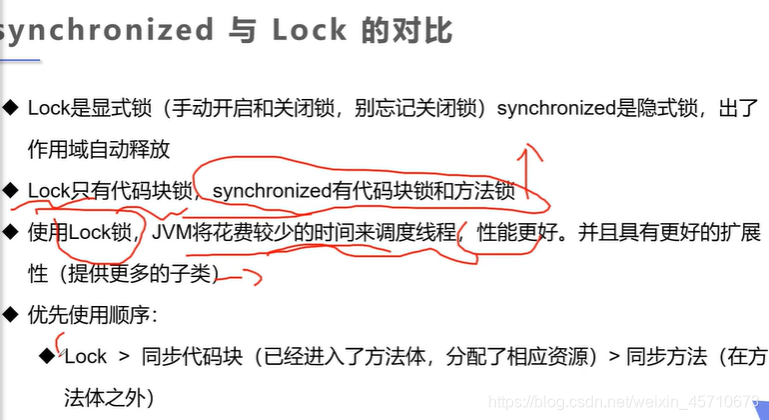- 线程同步(队列+锁)会损失性能是肯定的
- 并发:同一个对象被多个线程所控制。同一个时间片
- 并行:同一时刻
处理多线程问题时,多个线程访问同一个对象,并且某些线程还想修改这个对象。这个时候我们就需要线程同步,线程同步其实就是一种等待机制,多个需要同时访问此对象的线程进入这个*对象的等待池*形成队列,等待前面线程使用完毕,下一个线程再使用。
- 由于同一个进程的线程共享同一块存储空间,在带来方便的同时,也带来了访问冲突问题,为了保证数据在被访问时的正确性,在访问时加入***锁机制 synchornized,当一个线程获得对象的排他锁,独占资源,其他线程必须等待,使用后释放锁即可。存在以下问题:
- 一个线程持有锁会导致其他使用该锁的线程挂起
- 在多线程竞争下,加锁,释放锁会导致比较多的上下文切换和调度延时,引起性能问题
- 如果一个优先级高的线程等待一个优先级低的线程,会导致优先级倒置,引发各种性能问题
- 鱼和熊掌不可兼得,安全和性能不可兼得
- 同步方法

- 同步方法
- java里面是利用get、set方法来对java对象进行保护机制。在进程里面,我们只需要针对方法提出一套机制,这套机制就是synchronized
-
synchronized方法
-
synchronized块(synchronized(obj){})obj通常为需要修改的对象,比如:银行里的账户
- obj称为同步监视器;他可以是任何对象,但是推荐使用共享资源作为同步监视器;同步方法中无需指定同步监视器,因为同步方法的同步监视器就是this,就是这个对象本身,或者是class(反射中讲)
- 同步监视器的执行过程
- 第一个线程访问,锁定同步监视器,执行其中代码
- 第二个线程访问,发现同步监视器被锁定,无法访问
- 第一个线程访问完毕,解锁同步监视器
- 第二个线程访问,发现同步监视器没有锁,然后锁定并访问
同步方法:public synchronized void method(int args){}
-
synchronized方法控制对“对象”的访问,每个对相对应一把锁,每个synchronized方法都必须获得调用该方法的对象的锁才能执行,否则会造成线程堵塞,方法一旦执行,就独占该锁,直到该方法返回时才释放锁,后面被阻塞的线程才能获得这个锁,继续执行
缺陷:若将一个大的方法申明为synchronized将会影响效率
案例:1.买票2.list3.银行4.JUC
public class BuyTicket {
public static void main(String[] args) {
Buyer buyer = new Buyer();
new Thread(buyer,"a").start();
new Thread(buyer,"b").start();
new Thread(buyer,"c").start();
}
}
//买票
class Buyer implements Runnable {
private int tnum=10;
private boolean flag=true;
@Override
public void run() {
while(flag) {
buy();
}
}
public synchronized void buy() {
if(tnum<=0) {
flag=false;
return;
}
System.out.println(Thread.currentThread().getName()+"买到了"+tnum);
tnum--;
}
}
public class ConnNosafe {
public static void main(String[] args) {
List<String> list = new ArrayList<String>();
for (int i = 0; i < 1000000; i++) {
new Thread(()->{
synchronized (list) {
list.add(Thread.currentThread().getName());
}
}).start();
}
System.out.println(list.size());
}
}
public class GiveMoney {
public static void main(String[] args) {
Ancount a = new Ancount("结婚", 1000);
Bank c = new Bank(a, 950, "cc");
Bank b = new Bank(a, 100, "bb");
c.start();
b.start();
}
}
//账户
class Ancount {
String name;
int mString;
public Ancount(String name, int mString) {
super();
this.name = name;
this.mString = mString;
}
}
//银行
class Bank extends Thread {
private Ancount a;
private int getMoney;
private int handMoney;
public Bank(Ancount a, int getMoney, String name) {
super(name);
this.a = a;
this.getMoney = getMoney;
}
@Override
public void run() {
synchronized (a) {
if(getMoney >= a.mString) {
System.out.println(Thread.currentThread().getName()+"-->"+a.name + "账户余额不足");
return;
}
handMoney += getMoney;
a.mString -= getMoney;
System.out.println(a.name +"余额为" + a.mString);
System.out.println(Thread.currentThread().getName() +"手里的钱有" + handMoney);
}
}
}
public class TestJUCList {
public static void main(String[] args) {
CopyOnWriteArrayList<String> list = new CopyOnWriteArrayList<String>();
for (int i = 0; i < 10000; i++) {
new Thread(()->{
list.add(Thread.currentThread().getName());
}).start();
}
System.out.println(list.size());
}
}
- 死锁
- 两个资源共同抢夺一个资源,然后谁都不放手,最后资源崩溃,这就叫死锁。官方:某一个同步块同时拥有“两个以上对象的锁”。(多个线程相互抱着对方所需要的资源,然后形成僵持。)
案例:化妆
public class TestDeadLock {
public static void main(String[] args) {
makeUp g1 = new makeUp(1, "sb");
makeUp g2 = new makeUp(0, "zz");
g1.start();
g2.start();
}
}
//镜子
class mirror {
}
//口红
class mouthRed {
}
//化妆
class makeUp extends Thread {
static mirror m=new mirror();
static mouthRed mRed=new mouthRed();
private int choice;
private String girlString;
public makeUp(int choice, String girlString) {
super();
this.choice = choice;
this.girlString = girlString;
}
@Override
public void run() {
try {
make();
} catch (InterruptedException e) {
e.printStackTrace();
}
}
private void make() throws InterruptedException {
if(choice == 0) {
synchronized (m) {
System.out.println(this.girlString + "获得了镜子的锁");
Thread.sleep(1000);
synchronized (mRed) {
System.out.println(this.girlString + "获得了口红的锁");
}
}
}else {
synchronized (mRed) {
System.out.println(this.girlString + "获得了口红的锁");
Thread.sleep(2000);
synchronized (m) {
System.out.println(this.girlString + "获得了镜子的锁");
}
}
}
}
}
上面是死锁,解决方法是把那个syn块拿出来就行,别让他们同时调用对方的锁
public class TestDeadLock {
public static void main(String[] args) {
makeUp g1 = new makeUp(1, "sb");
makeUp g2 = new makeUp(0, "zz");
g1.start();
g2.start();
}
}
//镜子
class mirror {
}
//口红
class mouthRed {
}
//化妆
class makeUp extends Thread {
static mirror m=new mirror();
static mouthRed mRed=new mouthRed();
private int choice;
private String girlString;
public makeUp(int choice, String girlString) {
super();
this.choice = choice;
this.girlString = girlString;
}
@Override
public void run() {
try {
make();
} catch (InterruptedException e) {
e.printStackTrace();
}
}
private void make() throws InterruptedException {
if(choice == 0) {
synchronized (m) {
System.out.println(this.girlString + "获得了镜子的锁");
Thread.sleep(1000);
}
synchronized (mRed) {
System.out.println(this.girlString + "获得了口红的锁");
}
}else {
synchronized (mRed) {
System.out.println(this.girlString + "获得了口红的锁");
Thread.sleep(2000);
}
synchronized (m) {
System.out.println(this.girlString + "获得了镜子的锁");
}
}
}
}
- 产生死锁的四个必要条件
- 互斥条件:一个资源每次只能被一个进程使用
- 请求与保持条件:一个进程因请求资源而堵塞时,对已获得的资源保持不放
- 不剥夺条件:进程已获得的资源,在未使用完之前,不能强行剥夺
- 循环等待条件:若干进程之间形成一种头尾相接的循环等待资源关系
要想破坏死锁,只要想办法破坏其中的任意一个或者多个条件就可以避免死锁发生 - Lock锁
- 从jdk5.0开始,java提供了更强大的线程同步机制—通过显式定义同步锁对象来实现同步。同步锁使用lock对象充当。
- java.util.concurrent.lock.Lock接口是控制多个线程对共享资源进行访问的工具。锁提供了对共享资源的独占访问,每次只能有一个线程对Lock对象加锁,线程开始访问共享资源之前应先获得Lock对象
- ReentrantLock类实现了Lock,它拥有与synchroized相同的并发性和内存语义,在实现线程安全的控制中,比较常用的是ReentrantLock,可以显示加锁、释放锁。
public class TestLockLock {
public static void main(String[] args) {
Buy buy = new Buy();
new Thread(buy).start();
new Thread(buy).start();
new Thread(buy).start();
}
}
class Buy implements Runnable {
private int t=10;
//定义Lock锁
private final ReentrantLock l = new ReentrantLock();
//加锁
@Override
public void run() {
while(true) {
try {
l.lock();
if(t>=0) {
System.out.println(t);
t--;
}else {
break;
}
}finally {
l.unlock();
}
}
}
}























 1090
1090











 被折叠的 条评论
为什么被折叠?
被折叠的 条评论
为什么被折叠?








